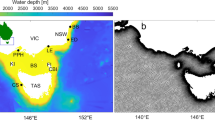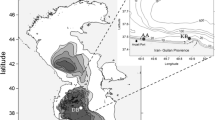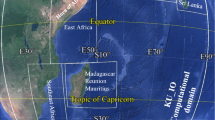Abstract
Waves are important driving forces that have significant implications in deep and shallow waters. To achieve further understanding of the characteristics of wind waves in the Gulf of Mannar, an attempt is made based on the measured data off Kulasekharapatnam for the period from January 2006 to May 2007. The integrated third-generation ocean wave models, WAM and SWAN, are implemented to simulate the significant wave parameters. Simulations were carried out using ECMWF ERA-Interim winds over the deep waters (30°E–120°E; 70°S–30°N and 76°E–80°E; 6°N–10°N) domains. Comparison of the ECMWF ERA-Interim wind data against the field measured data demonstrates that the overall trend and dominant directions are consistent with the observational data. The validation of significant wave parameters exhibited very high correlation (R > 0.9) at the study location. Wave heights are high in the Gulf of Mannar during the southwest monsoon period and the waves are from south-southwest. The study also shows that swells are predominant (24%) in the Gulf of Mannar during non-monsoon period and during rest of the year, wind sea (75.9%) dominates. The study also demonstrates the sensitivity of the SWAN model towards different GEN3 physics options and bottom friction formulations by forcing the model with QuikSCAT/NCEP Blended winds off Kulasekharapatnam. The simulations obtained using different GEN3 physics options and bottom friction formulations have been compared with the buoy data. The study indicates that the SWAN model with Janssen and Komen physics options simulates the significant wave height and mean wave period, respectively, with a fairly high degree of accuracy. Similarly, the JONSWAP formulation for bottom friction reproduced the buoy signals at the study location with good accuracy for both significant wave height and mean wave period. The study demonstrates that the simulations are sensitive to the choice of GEN3 physics and bottom friction formulations off Kulasekharapatnam, and hence effective for obtaining more accurate wave predictions.













Similar content being viewed by others
References
Aboobacker, V. M., Vethamony, P., Sudheesh, K., & Rupali, S. R. (2009). Spectral characteristics of the near-shore waves off Paradip, India during monsoon and extreme events. Natural Hazards, 49, 311–323.
Anonymous. (2011). Indian tide tables 2011, Indian and selected foreign Ports. New Delhi: Survey of India, Government of India.
Ardhuin, F., Bertotti, L., Bidlot, J. R., Cavaleri, L., Filipetto, V., Lefevre, J. M., et al. (2007). Comparison of wind and wave measurements and models in the western Mediterranean sea. Ocean Engineering, 34, 526–541.
Booij, N., Ris, R. C., & Holthuijsen, L. H. (1999). A third generation wave model for coastal regions: 1. Model description and validation. Journal of Geophysical Research, 104(C4), 7649–7666.
Caires, S., & Sterl, A. (2005). A new non parametric method to correct model data: application to significant wave height from the ERA-40 re-analysis. Journal of Atmospheric and Oceanic Technology, 22(4), 443–459.
Castelle, B., Bonneton, P., Senechal, N., Dupuis, H., Butel, R., & Michel, D. (2006). Dynamic of wave induced currents over an alongshore non-uniform multiple-barred sandy beach on the Aquitanian Coast, France. Continental Shelf Research, 26, 113–131.
Cavaleri, L., & Sclavo, M. (2006). The calibration of wind and wave model data in the Mediterranean Sea. Coastal Engineering Journal, 53(7), 613–627.
Chandramohan, P., Kumar, V. S., & Nayak, B. U. (1993). Coastal processes along shore front of Chilka Lake, east coast India. Indian Journal of Marine Science, 22, 268–272.
Cherian, A., Chandrasekar, N., Gujar, A. R., & Rajamanickam, V. (2012). Coastal erosion assessment along the southern Tamil Nadu coast, India. International Journal of Earth Science Engineering, 5(2), 352–357.
Collins, J. I. (1972). Predictions of shallow-water spectra. Journal of Geophysical Research, 77, 2693–2707.
Dee, D. P. (2011). The ERA-Interim reanalysis: Configuration and performance of the data assimilation system. Quarterly Journal of the Royal Meteorological Society, 137, 553–597.
Dingemans, M. W. (1997). Water wave propagation over uneven bottoms, part 1, linear wave propagation. Advance series in ocean engineering (Vol. 13, p. 471). River Edge: World Science.
Gowthaman, R., Kumar, V. S., Dwarakish, G. S., Soumya, S. M., Singh, J., & Kumar, K. A. (2013). Waves in Gulf of Mannar and Palk Bay around Dhanushkodi, Tamil Nadu, India. Current Science, 104, 1431–1435.
Gowthaman, R., Sanil Kumar, V., Dwarakish, G. S., Shanas, P. R., Jena, B. K., & Singh, J. (2015). Nearshore waves and longshore sediment transport along Rameswaram Island off the east coast of India. International Journal of Naval Architecture and Ocean Enginering, 7, 939–950.
Gunther, H., & Behrens, A. (2011). The WAM model–validation document version 4.5.3. Teltow: Helmholtz-Zentrum Geesthacht (HZG), Centre for Materials and Coastal Research.
Hasselmann, K., Barnett, T. P., Bouws, E., Carlson, H., Cartwright, D. E., Enke, K., et al. (1973). Measurements of wind–wave growth and swell decay during the Joint North Sea Wave Project (JONSWAP). Deutsche Hydrographische Zeitschrift Supplement, A, 8(12), 1–95.
Kalnay, E., Kanamitsu, R., Kistler, R., Collins, W., Deaven, D., Gandin, L., et al. (1996). The NCEP/NCAR 40-year reanalysis project. Bulletin of the American Meteorological Society, 77, 437–471.
Komen, G. J., Hasselmann, S., & Hasselmann, K. (1984). On the existence of a fully developed wind-sea spectrum. Journal of Physical Oceanography, 14, 1271–1285.
Kumar, V. S., Anand, N. M., Kumar, K. A., & Mandal, S. (2003). Multipeakedness and groupiness of shallow water waves along Indian coast. Journal of Coastal Research, 19, 1052–1065.
Kumar, V. S., Kumar, K. A., & Raju, N. S. N. (2004). Wave characteristics off Visakhapatnam coast during a cyclone. Current Science, 86, 1524–1529.
Kumar, V. S., Pathak, K. C., Padnekar, P., Raju, N. S. N., & Gowthaman, R. (2006). Coastal processes along the Indian coastline. Current Science, 91, 530–536.
Loveson, V. J. (1994). Geological and geomorphological investigations related to sea level variation and heavy mineral accumulation along the Southern Tamilnadu Beaches, India. Unpublished Ph.D. thesis, Madurai Kamaraj University, Madurai.
Madsen, O. S., Poon, Y. K., & Graber, H. C. (1988). Spectral wave attenuation by bottom friction: Theory. Proc. 21th Int. Conf. Coastal Engineering, ASCE, pp. 492–504.
Mazaheri, S., Kamranzad, B., & Hajivalie, F. (2013). Modification of 32 years ECMWF wind field using QuikSCAT data for wave hindcasting in Iranian Seas. Journal of Coastal Research, 1(65), 344–349.
Milliff, R. F., Large, W. G., Morzel, J., Danabasoglu, G., & Chin, T. M. (1999). Ocean general circulation model sensitivity to forcing from scatterometer winds. Journal of Geophysical Research, 12, 11337–11358.
Moeini, M. H., Etemad-Shahidi, A., & Chegini, V. (2010). Wave modeling and extreme value analysis off the northern coast of the Persian Gulf. Applied Ocean Research, 32, 209–218.
Nayak, S., Bhaskaran, P. K., Venkatesan, R., & Dasgupta, S. (2013). Modulation of local wind waves at Kalpakkam from remote forcing effects of Southern Ocean swells. Ocean Engineering, 64, 23–35.
Nayak, B. U., Chandramohan, P., & Sakhardande, R. K. (1992). Seasonal distribution of wave heights off Yanam on the east coast of India. Indian Journal of the Institution of Engineers, 72, 187–193.
Neetu, S., Shetye, S., & Chandramohan, P. (2006). Impact of sea breeze on wind-seas off Goa, west coast of India. Journal of Earth System Sciences, 1(15), 2031–2038.
Pillar, P., Guedes, S. C., & Carretero, J. C. (2008). 44-year wave hindcast for the North East Atlantic European coast. Coastal Engineering, 55, 861–871.
Pond, S., & Pickard, G. J. (1991). Introductory dynamical oceanography (2nd ed., p. 329). Oxford: Pergamon Press.
Portilla, J., Ocampo-Torres, F. J., & Monbaliu, J. (2009). Spectral partitioning and identification of wind sea and swell. Journal of Atmospheric and Oceanic Technolology, 26, 117–122.
Prasad Kumar, B., Pang, I. C., Rao, A. D., Kim, T. H., Nam, J. C., & Hong, C. S. (2003). Seastate hindcast for the Korean seas with a spectral wave model and validation with buoy observation during January 1997. Journal of the Korean earth science society, 24, 7–21.
Prasad Kumar, B., & Stone, G. W. (2007). Numerical simulation of typhoon wind forcing in the Korean seas using a spectral wave model. Journal of Coastal Research, 23, 362–373.
Premkumar, K., Ravichandran, M., Kalsi, S. R., Sengupta, D., & Gadgil, S. (2000). First results from a new observational system over the Indian seas. Current Science, 78, 323–330.
Rao, N. S. B., & Mazumdar, S. (1996). A technique for forecasting storm waves. Indian Journal of Meteorology and Geophysics, 1996(17), 333–346.
Reddy, M. P. M. (2001). Descriptive physical oceanography (p. 440). A.A. Balkema Publishers: Mangalore. ISBN 90-5410-706-5.
Ris, R. C. (1997). Spectral modelling of wind waves in coastal waters. (Ph.D. thesis, Delft University Press, Netherlands), p 160.
Saket, A., Etemad-Shahidi, A., & Moeini, M. H. (2013). Evaluation of ECMWF wind data for wave hindcasting in Chabahar zone. Proceedings of 12th International Coastal Symposium (Plymouth, England), Journal of Coastal Research, Special Issue 65, pp. 380–385.
Schneggenburger, C., Gunther, H., & Rosenthal, W. (2000). Spectral wave modeling with non-linear dissipation: Validation and applications in a coastal tidal environment. Coastal Engineering, 41, 201–235.
Senan, R., Anitha, D. S., & Sengupta, D. (2001). Validation of SST and wind speed from TRMM using north Indian Ocean moored buoy observations. CAOS Report 2001AS1, Centre for Atmospheric Sciences, Indian Institute of Science, Bangalore, India.
Sengupta, D., Goswami, B. N., & Senan, R. (2001). Coherent intra-seasonal oscillations of ocean and atmosphere during Asian Summer monsoon. Geophysical Research Letters, 28, 4127–4130.
Signell, R. P., Carniel, S., Cavaleri, L., Chiggiato, J., Doyle, J. D., Pullen, J., et al. (2005). Assessment of wind quality for oceanographic modelling in semi-enclosed basins. Journal of Marine Systems, 53, 217–233.
Sorensen, R. M. (1997). Basic coastal engineering. New York: Springer Science.
Sundar, V., & Ananth, P. N. (1988). Wind climate for Madras harbor, India. Journal of Wind Engineering and Industrial Aerodynamics, 31, 323–333.
Swain, J. (1997). Simulation of wave climate for Indian Seas. Ph.D. thesis, Cochin University of Science and Technology, India.
Thompson, T. S., Nelson A. R., & Sedivy, D. G. (1984). Wave group anatomy. Proceedings of 19th Conference on Coastal Engineering, American Society of Civil Engineers, vol. 1, pp. 661–677.
Tolman, H. L. (1991). A third generation model for wind waves on slowly varying, unsteady and inhomogeneous depths and currents. Journal of Physical Oceanography, 21, 782–797.
Venkatesan, R., Lix, J. K., Phanindra, R. A., Arul, M. M., & Atmanand, M. A. (2016). Two decades of operating the Indian moored buoy network: significance and impact. Journal of Operational Oceanography, 9(1), 45–54.
WAMDIG. (1988). The WAM model—A third generation ocean wave prediction model. Journal of Physical Oceanography, 18, 1775–1810.
Wang, D. W., & Hwang, P. A. (2011). An operation method for separating wind sea and swell from the ocean wave spectra. Journal of Atmospheric and Oceanic Technology, 18, 2052–2062.
Acknowledgements
The authors express their sincere thanks to INCOIS (Indian National Centre for Ocean Information Services, Hyderabad), Ministry of Earth Sciences, Government of India for the wave data used in this study.
Author information
Authors and Affiliations
Corresponding author
Rights and permissions
About this article
Cite this article
P. A, U., Kani, S.P. & Bhaskaran, P.K. Numerical Simulation of Wave Characteristics off Kulasekharapatnam, Southeast Coast of India. Pure Appl. Geophys. 174, 3979–4001 (2017). https://doi.org/10.1007/s00024-017-1599-6
Received:
Revised:
Accepted:
Published:
Issue Date:
DOI: https://doi.org/10.1007/s00024-017-1599-6




